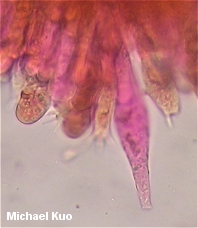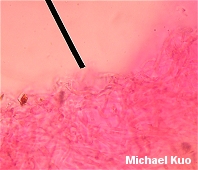| Major Groups > Gilled Mushrooms > Pale-Spored > Lactarius > Lactarius argillaceifolius var. megacarpus |

|
Lactarius argillaceifolius var. megacarpus [ Agaricomycetes > Russulales > Russulaceae > Lactarius . . . ] by Michael Kuo This West-Coast mushroom is currently considered a variety of the eastern North American species Lactarius argillaceifolius, but its differences are substantial and it would not surprise me if DNA analysis were to reveal separate phylogenetic species--in which case the rules of taxonomy would dictate that the West-Coast mushroom become "Lactarius megacarpus." Lactarius argillaceifolius var. megacarpus is a large, messy species of Lactarius associated with coast live oak and tanoak from southern Oregon to Baja California. Its cap, when fresh, is a dingy purplish color; its gills become dingy yellowish with age; and its off-white milk stains surfaces dingy brownish . . . in short, it's a dingy mushroom. Under the microscope it features partially reticulate, ellipsoid spores with low ornamentation. Description: Ecology: Mycorrhizal with coast live oak and tanoak; growing alone or gregariously; winter; coastal Oregon to Baja California. Cap: 7-30 cm across when mature; convex, becoming flat with a central depression, or shallowly vase-shaped; drab lilac brown, fading to dirty buff; without zones; bald or minutely pocked and rugged; slimy when fresh. Gills: Broadly attached to the stem; close or nearly distant; creamy whitish when young, but soon becoming dirty yellowish and, eventually, pale dingy cinnamon; stained slowly brownish to brown or brownish gray by the latex where damaged. Stem: 6-20 cm long; 2-5 cm thick; more or less equal; whitish, discoloring to yellowish or brownish in age; dry or slightly sticky; bald; without potholes. Flesh: Whitish; unchanging on exposure. Milk: Off-white; unchanging when exposed; staining tissues brown to brownish. Odor and Taste: Odor not distinctive; taste weakly to moderately acrid (especially the latex). Spore Print: Whitish to very pale yellowish. Chemical Reactions: KOH on cap surface yellow. Microscopic Features: Spores 7-10.5 x 6.5-8 µ; broadly ellipsoid; ornamentation under 0.5 µ high, composed of warts and ridges that often form partial reticula. Pleuromacrocystidia fusiform; to about 100 µ long. Cheilomacrocystidia similar but usually shorter. Pileipellis an ixocutis or ixolattice. REFERENCES: Hesler & Smith, 1979. (Smith, Smith & Weber, 1979; Arora, 1986; Canduso, Genari & Ayala, 1994; Methven, 1997.) Herb. Kuo 01150505. This site contains no information about the edibility or toxicity of mushrooms. |
© MushroomExpert.Com |
|
Cite this page as: Kuo, M. (2011, February). Lactarius argillaceifolius var. megacarpus. Retrieved from the MushroomExpert.Com Web site: http://www.mushroomexpert.com/lactarius_argillaceifolius_megacarpus.html |



